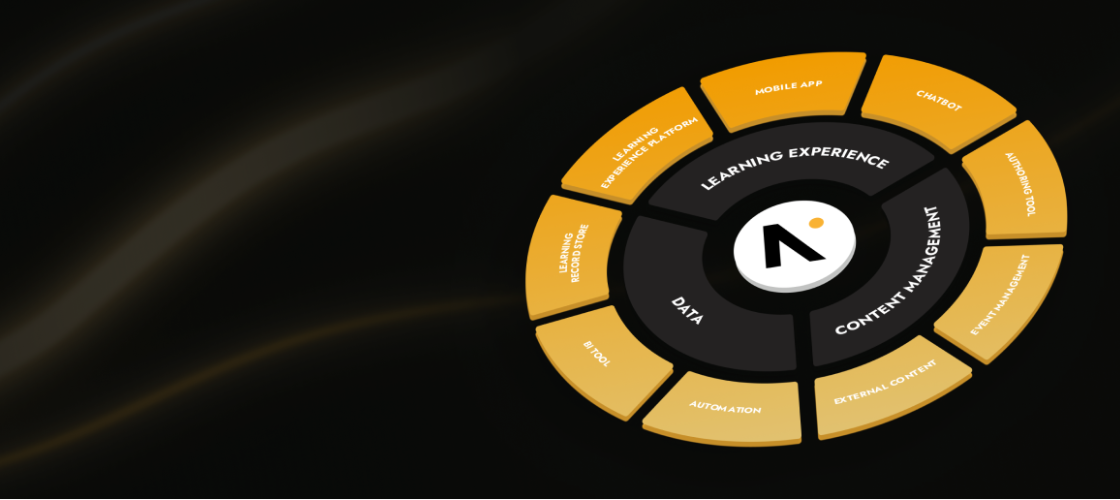The learning suite: the learning ecosystem of the future.
There is plenty of investment in learning. A tremendous step forward. Companies of all shapes and sizes are looking into ways to help employees develop. There is great demand for a learning ecosystem that is flexible and "talks" to all the systems already in use in an organization. Such a learning ecosystem consists of so much more than just a platform where content is ready to go. And we have such a learning ecosystem: the Learning Suite.
The Learning Suite is a dynamic ecosystem of learning tools aligned to help the learner develop with learning experiences. Quite a mouthful. That's why we visualized the Learning Suite and mapped out the different layers, including learning tools.

The first layer: learning experience
This layer relates to all learning. This is made possible by our LXP (Learning Experience Platform). This is where all learning takes place. The participant logs in and has all kinds of learning experiences available there. In total there are 44 different learning experiences. These range from reading an article to interviewing an expert. He can also access these learning experiences through a mobile app. The app allows the learner to work offline. Once connected, the progress is synchronized. If an organization works with Microsoft Teams and/or Slack app, employees can access the LXP through the chatbot. This makes it possible to quickly look something up while working.
The second layer: content management
The second layer contains the learning offerings and their management. Content developed with authoring tools is made available here. The learning offerings in this layer can be huge and diverse. For example, you can add your own content from providers such as YouTube and Vimeo, as well as from external providers such as LinkedIn Learning and Goodhabitz. Managing events and scheduling a meeting with a coach or a mentor also takes place here. In addition, a client's existing LMS (Learning Management System) can be placed here.
The third layer: data
The use of data includes collecting and analyzing learning behavior. All (learning) data is collected, visualized and analyzed and where possible even automated and personalized. Thus, each participant receives the learning offer that matches his/her interests and behavior. This is made possible through automation: participants are nudged with new content and encouraged to develop even further with a notification. We work with advanced data analysis tools, such as a Learning Record Store and a Bi Tool.
What learning tools does the Learning Suite consist of?
In total, the Learning Suite =consists of nine learning tools. These are:
- The Learning Experience Platform (LXP) where all learning takes place
- The chatbot enabling workplace learning
- The mobile app enabling learning anytime, anywhere
- The authoring tool used to create e-learning content
- Event management that manages events and meetings
- External content through which content from providers (Goodhabitz, LinkedIn Learning, Udemy) can be linked, but content from YouTube, Vimeo and Scorm can also be added
- Automation by which nudging is activated
- A BI tool to analyze data
- The Learning Record Store to properly collect and visualize (learning) data
The learning tools can be linked and "talk" to each other. Together, they reinforce the four concepts of Next Learning Valley (and the Learning Suite): personalized learning, social learning, data-driven learning and workplace learning.
Why is a learning ecosystem important for your organization?
A learning ecosystem facilitates employee development in a flexible manner. The world of learning is changing rapidly. The focus is increasingly on up- and reskilling employees so that they can be flexibly deployed in the organization. This flexibility is incredibly important at a time when personnel is scarce.
The Learning Suite itself is also flexible. It moves with the needs of the organization. Learning tools can be added and tools that are no longer needed, or where a better version is on the market, can go away. And precisely because the Learning Suite is in flux, employee development will remain in flux.
We hear you thinking "but what are the main reasons to start using Learning Suite?" No worries. We share four with you:
- If you are serious about up- and reskilling employees, the Learning Suite provides all the tools you need to make it a success.
- With a Learning Suite, you create a flexible learning environment that encourages employee development.
- The Learning Suite facilitates personalized, social, workplace and data-driven learning.
- With the Learning Suite, you offer employees learning experiences that are many times more effective over time than traditional content dumps.
Why do you want to implement the Learning Suite with us?
Offering complete learning ecosystems like our Learning Suite doesn't happen much in the Netherlands yet. The demand is there and more and more large companies are open to it. Offering the Learning Suite is not only unique, but also its implementation. As an educational implementation partner, we provide the technology, the knowledge, the migration of any old system to the Learning Suite and we build all the links.
Also, each tool has its own function within the Learning Suite and can be tailored entirely to your needs. Hans Ramaker, our implementor, has a wealth of experience in implementing learning environments. He personally guides organizations through every step of the implementation.
Our team of experts helps your organization innovate with learning. And we do so with tremendous passion.
Would you like to learn more about the Learning Suite?
Then book a no-obligation introductory meeting with us now.